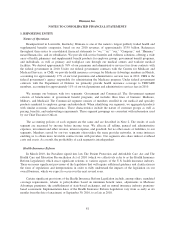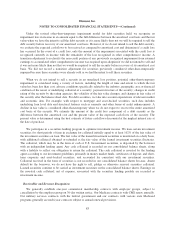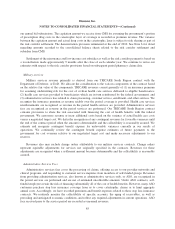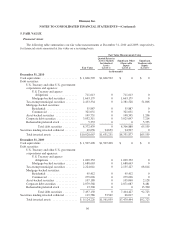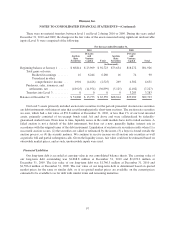Humana 2010 Annual Report Download - page 100
Download and view the complete annual report
Please find page 100 of the 2010 Humana annual report below. You can navigate through the pages in the report by either clicking on the pages listed below, or by using the keyword search tool below to find specific information within the annual report.Humana Inc.
NOTES TO CONSOLIDATED FINANCIAL STATEMENTS—(Continued)
Fair value of actively traded debt securities are based on quoted market prices. Fair value of other debt
securities are based on quoted market prices of identical or similar securities or based on observable inputs like
interest rates generally using a market valuation approach, or, less frequently, an income valuation approach and
are generally classified as Level 2. We generally obtain one quoted price for each security from a third party
pricing service. These prices are generally derived from recently reported trades for identical or similar
securities, including adjustments through the reporting date based upon observable market information. When
quoted prices are not available, the third party pricing service may use quoted market prices of comparable
securities or discounted cash flow analyses, incorporating inputs that are currently observable in the markets for
similar securities. Inputs that are often used in the valuation methodologies include benchmark yields, reported
trades, credit spreads, broker quotes, default rates and prepayment speeds. We are responsible for the
determination of fair value and as such we perform analysis on the prices received from the third party pricing
service to determine whether the prices are reasonable estimates of fair value. Our analysis includes a review of
monthly price fluctuations as well as a quarterly comparison of the prices received from the pricing service to
prices reported by our third party investment advisor.
Fair value of privately held debt securities, including venture capital investments as well as auction rate
securities, are estimated using a variety of valuation methodologies, including both market and income
approaches, where an observable quoted market does not exist and are generally classified as Level 3. For
privately-held debt securities, such methodologies include reviewing the value ascribed to the most recent
financing, comparing the security with securities of publicly-traded companies in similar lines of business, and
reviewing the underlying financial performance including estimating discounted cash flows. For auction rate
securities, such methodologies include consideration of the quality of the sector and issuer, underlying collateral,
underlying final maturity dates, and liquidity.
Recently Issued Accounting Pronouncements
In January 2010, the Financial Accounting Standards Board, or FASB issued new guidance that expands and
clarifies existing disclosures about fair value measurements. Under the new guidance, we are required to disclose
additional information about movements of assets among the three-tier fair value hierarchy, present separately
(that is, on a gross basis) information about purchases, sales, issuances, and settlements of financial instruments
in the reconciliation of fair value measurements using significant unobservable inputs (Level 3), and expand
disclosures regarding the determination of fair value measurements. We adopted the new disclosure provisions
during the year ended December 31, 2010, except for the gross disclosures regarding purchases, sales, issuances
and settlements in the roll forward of activity in Level 3 fair value measurements which will be effective for us
beginning with the filing of our Form 10-Q for the three months ending March 31, 2011.
In October 2010, the FASB issued new guidance that modifies the types of costs that can be capitalized in
the acquisition of insurance contracts. We defer policy acquisition costs, primarily commissions, associated with
our health, life insurance, annuities, and other supplemental policies sold to individuals and accounted for as
long-duration insurance products because they are expected to remain in force for an extended period beyond one
year. Premiums under our long-duration insurance products represented approximately 2% of our total premiums
and ASO fees for the year ended December 31, 2010. The new guidance specifies that only costs that are related
directly to the successful acquisition of insurance contracts qualify for deferral. Commissions representing direct
costs of contract acquisitions will continue to qualify for capitalization. The new guidance is effective for us
January 1, 2012 with early adoption permitted January 1, 2011. We currently are evaluating the impact of the
new guidance on our results of operations and financial position.
90



